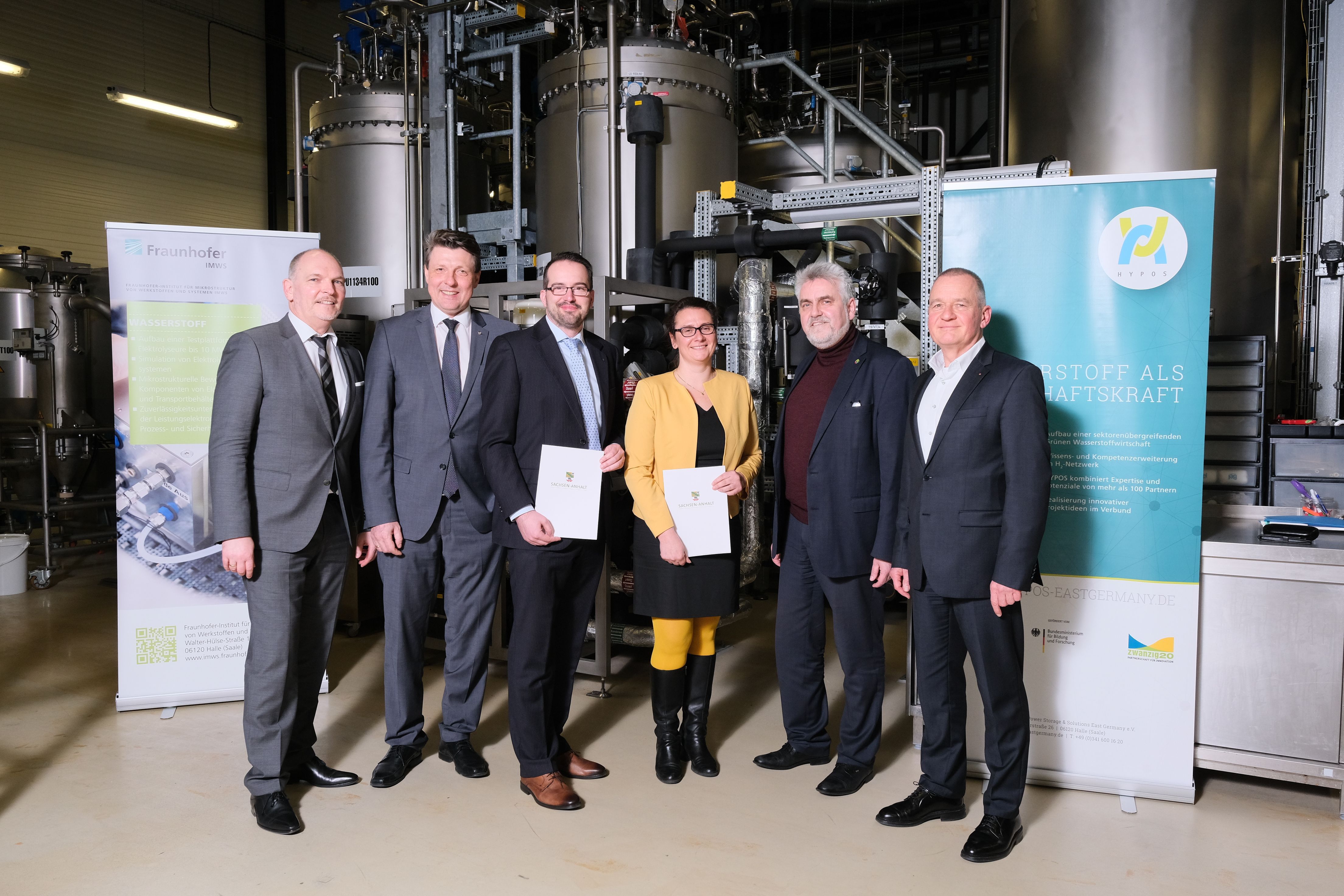»Green« hydrogen on a large scale
Hydrogen is regarded as the energy source of the future – and rightly so, if it is »green« and is produced from water using electricity generated from renewable energies. With the HLL Hydrogen Lab at the Leuna chemical site, Saxony-Anhalt and the Fraunhofer-Gesellschaft are setting new standards. Today, the state’s Minister of Economic Affairs, Science and Digitalization, Professor Armin Willingmann, handed over the approval notice for the HLL and the scaling platform Hy2Chem. This platform is intended to use the hydrogen produced on a large scale for the sustainable production of basic chemicals and fuels.


The Central German chemical region requires around 100,000 standard cubic meters of hydrogen per hour, mainly at the industrial site in Leuna for its chemical processes. Until now, the hydrogen required has been obtained conventionally from natural gas. This makes the chemical region not only one of the largest users of hydrogen, but also one of the largest emitters of CO2. This is about to change. This is because hydrogen can – with electricity from renewable energy – also be produced from water in an environmentally friendly and climate-neutral way: Water is split into hydrogen and oxygen by electrolysis in electrolyzers.
With a unique research unit, the Fraunhofer Hydrogen Lab Leuna HLL, innovative technologies for the large-scale production of regenerative hydrogen will in future be combined with an excellent infrastructure of gas pipelines and gas storage systems at the Leuna chemical site. The development and scaling of new electrolysis systems and the chemical use of »green« hydrogen produced with regenerative energy will be jointly promoted by the Fraunhofer Center for Chemical-Biotechnological Processes CBP in Leuna and the Fraunhofer Institute for Microstructure of Materials and Systems IMWS in Halle (Saale).
On March 4, the Minister for Economic Affairs of Saxony-Anhalt, Professor Dr. Armin Willingmann, presented the approval notices for the Fraunhofer HLL and Hy2Chem at the Fraunhofer CBP. »Green hydrogen is a central piece of the puzzle of the ongoing energy transition and also offers huge potential for structural change after the fossil fuel phase-out. Thanks to its expertise and infrastructure, the Leuna site has the best prerequisites for becoming the nucleus of a German hydrogen economy. To achieve this, we must succeed in making the production of hydrogen using renewable energies a success on an industrial scale as well. The state-supported construction of the two pilot plants, to which industry is also contributing significantly, will lay the foundation for this. It will also pave the way for a low-CO2 or CO2-free chemical industry,« said Willingmann.
Professor Ralf B. Wehrspohn, Chief Technology Officer of the Fraunhofer-Gesellschaft and Deputy Chairman of HYPOS e.V., emphasized in a welcoming address the importance of the pilot plants under construction for the successful management of structural change: »As a location for raw materials, chemicals and energy, Central Germany is very well placed to become a model region for a sustainable industrial society. With the combined expertise of two Fraunhofer establishments, we want to lend support on the way there and strengthen the innovative power and competitiveness of small and medium-sized enterprises in particular.«
The HLL is intended to prepare the site for the industrial implementation of processes aimed at producing »green« hydrogen. One of the central focuses is the further development of electrolyzers and synthesis processes that are adapted to fluctuating operation. In doing so, the researchers are particularly interested in depicting real operating conditions, which provide application-oriented engineering data for the design and cost estimation of the systems.
The production of »green« hydrogen or synthesis gas by means of the co-electrolysis of water and carbon dioxide in the HLL will be followed immediately by the construction of the Hy2Chem scaling platform. This will enable the regeneratively produced gases to be used for the first time on a large scale for the synthesis of basic chemicals and fuels in sustainable synthesis processes.
»With the electrolysis platform, we are creating the first electrolysis test facility in Germany that is fully integrated into a material flow network of the chemical industry. For example, we can systematically test electrolyzers and gain valuable experience in feeding hydrogen into the pipeline system of our cooperation partner Linde, initially up to 5 megawatts,« says Dr.-Ing. Sylvia Schattauer, who as Deputy Head of the Institute is responsible for hydrogen and carbon activities at the Fraunhofer IMWS.
»The Fraunhofer Center for Chemical-Biotechnological Processes CBP is contributing not only its many years of expertise in the operation of pilot and demonstration plants but also its extensive know-how in chemical process engineering. With new solutions for the use of green hydrogen as a chemical energy storage medium or in downstream chemical processes, we aim to increase the value added and make chemical syntheses more sustainable. And by scaling up electrochemical processes, we can prepare them for industrial implementation,« says Gerd Unkelbach, head of the Leuna site and coordinator of the Sustainable Chemistry business unit at the Fraunhofer Institute for Interfacial Engineering and Biotechnology IGB.
The groundbreaking ceremony for the HLL will take place in mid-2020, with the plant in Leuna scheduled to go into operation the following year. A total of over 10 million euros will be invested in the Hydrogen Lab and the Hy2Chem platform, part of which will come from the European Regional Development Fund (ERDF).
Here you can watch the image film "Germany's Next Generation Energy Hubs", in which the Fraunhofer IMWS was involved.